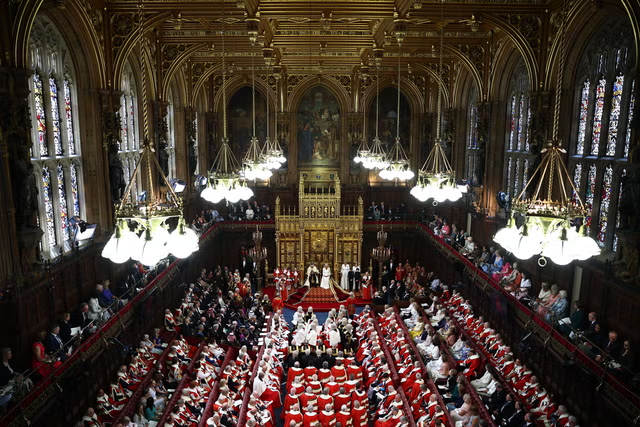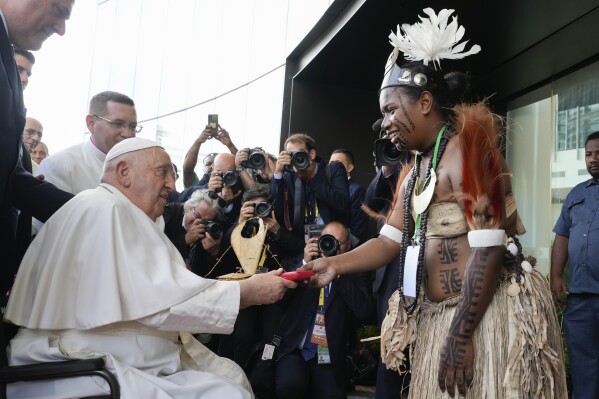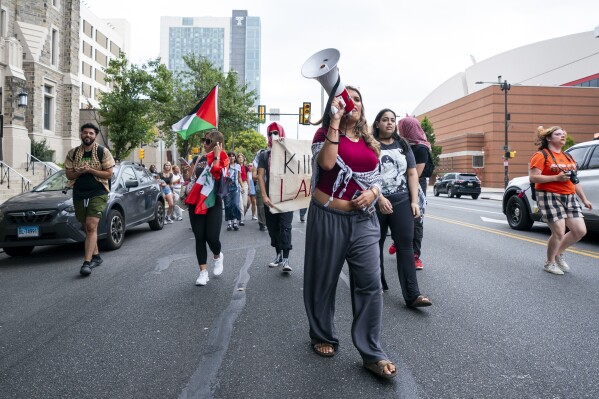MINNEAPOLIS (AP) — Gov. Tim Walz faced the biggest crisis of his political career when Minnesota’s two largest cities erupted in protests and riots after a white Minneapolis police officer killed George Floyd.
The Black man’s murder in 2020 sparked a nationwide reckoning over racial discrimination and police misconduct. His death, and its complicated aftermath, tested Walz’s leadership at one of the state’s most consequential moments.
What the governor did — or failed to do — during and after the violence in Minneapolis and St. Paul drew sharp criticism from Republicans in Minnesota. Nor did it satisfy some progressives who had urged him to take bolder steps to remake policing in the state. Walz’s defenders say he did an exemplary job under unprecedented circumstances.
Four years later, on the national stage as the Democratic nominee for vice president, Walz is facing similar questions and criticism: Republicans are calling him a left-wing radical who was too slow to act and some progressives are saying he was not radical enough in addressing police abuses.
A review by The Associated Press — based on government documents, consultant reports, news accounts, video and audio recordings, as well as interviews with families, activists, lawyers and public officials — paints a nuanced picture of how Walz handled the challenge. As a relatively new governor, he tried to balance the competing pressures and interests of local and federal officials, including then-President Donald Trump, while navigating the dangers posed by fast-evolving protests and riots taking place amid a deadly global pandemic.
“Sitting on the sidelines and critiquing, that’s not what being governor is. It’s making the hard decisions at the time,” Walz said during a gubernatorial debate in 2022.
He defended how local, state and federal authorities worked together, and said it should serve as model for other states. “I’m proud of Minnesota’s response; I’m proud of Minnesota’s first-responders who were out there, from firefighters to police to the National Guard, to citizens that were out there,” he said.
Fateful days in May
Floyd was killed on May 25, 2020, Memorial Day. Bystander video of his dying cries of “I can’t breathe” spread quickly, stoking outrage. The protests were mostly peaceful at first, albeit with some vandalism and clashes with police, as leaders struggled to balance the free-speech rights of protesters against the need to protect public safety.
Major looting started on May 27, two nights later. A Target store was plundered. An auto parts store and several other businesses were torched. The police chief asked the mayor to seek help from the National Guard. Minneapolis Mayor Jacob Frey would later say the governor hesitated, an accusation that Walz would deny.
Walz, a 24-year National Guard veteran, approved a limited activation on May 28 to protect firefighters and the State Capitol complex, and declared a peacetime emergency, though he continued to leave most of the response in the hands of local authorities.
The destruction only worsened that night. Protestors took control of the 3rd Precinct station, which soon caught fire and was destroyed. Guard troops did not arrive at the police station until several hours later, in the early hours of May 29.
What to know about the 2024 Election
- Today’s news: Follow live updates from the campaign trail from the AP.
- Ground Game: Sign up for AP’s weekly politics newsletter to get it in your inbox every Monday.
-
AP’s Role: The Associated Press is the most trusted source of information on election night, with a history of accuracy dating to 1848. Learn more.
That day, Walz criticized the “abject failure” of the city’s response. He said the state would take control and he imposed a nighttime curfew.
“I will assume responsibility,” Walz said, adding that he understood criticism that the state had not moved quickly enough. “That is on me,” he said.
After another night of violence between protesters and police, and more arson, the governor ordered a full mobilization of the Guard. He considered a Pentagon offer to send military police but he did not accept it. The next day, May 31, he said Attorney General Keith Ellison, who enjoyed trust within the Black community, would take over prosecution of the officers involved in Floyd’s death.
By the time most of the violence subsided, more than 1,500 businesses and buildings had been damaged, costing an estimated $500 million.
Republicans criticize state and local response
The Republican-controlled Minnesota Senate held a series of hearings on the unrest and the official response that July. The final report in October 2020 blamed a failure of executive leadership at the state and local level and a hesitation by the Democratic governor and city leaders to confront their ideological allies.
“Governor Walz, his administration and Mayor Frey failed to realize the seriousness of the riots and the danger to Minnesotans if rioters were not confronted and stopped,” the Senate GOP report said. “Both Governor Walz and Mayor Frey failed to act in a timely manner to confront rioters with necessary force due to an ill-conceived philosophical belief that such an action would exacerbate the rioting.”
During recent appearances in Minnesota, Trump falsely claimed that he personally was responsible for deploying the National Guard, even though it was actually Walz who gave the mobilization orders.
“Every voter in Minnesota needs to know that when the violent mobs of anarchists and looters and Marxists came to burn down Minneapolis four years ago — remember me? — I couldn’t get your governor to act,” the Republican presidential nominee said in July. “He’s supposed to call in the National Guard or the Army. And he didn’t do it.”
That contrasts sharply with the praise that Trump heaped on Walz as the dust settled on the crisis. Two days after Walz ordered the full National Guard mobilization, the then-president told governors and administration officials on a conference call that Minnesota’s chief executive had been doing a stellar job.
“What they did in Minneapolis was incredible. They went in and dominated, and it happened immediately,” Trump said, according to an audio recording of the call obtained by the AP. The audio shows that the president didn’t criticize the governor at the time. “Tim, you called up big numbers and the big numbers knocked them out so fast, it was like bowling pins,” Trump said.
Two nonpartisan external reviews, released in March 2022, found shortcoming in both the city’s and the state’s responses.
A report by the nonprofit Wilder Research, commissioned by the Department of Public Safety, cited a lack of clear leadership early on. The report said the state did not set up a multiagency command center until too late, four days after Floyd was killed. It said the center had a “chaotic beginning,” with no clear chain of command, while the city continued to operate its own emergency operations center with competing law enforcement strategies. The report also said the National Guard was mobilized too late.
A separate after-action report commissioned by the city and done by the risk management firm Hillard Heintze said Minneapolis officials who requested assistance from the Guard were unfamiliar with the process, which held up the approval and deployment of troops.
Walz is praised and criticized for his push for changes
In the months after the riots, Walz urged sweeping changes. He called lawmakers back into a special session that July. They banned neck restraints like the kind used on Floyd and imposed a duty to intercede on officers who see a colleague using excessive force.
Walz signed a modest police accountability package in 2021 that had some limits on no-knock warrants and created a police misconduct database. Later in 2021, the governor opposed a ballot measure in Minneapolis that had its roots in the “defund the police” movement. With Democrats in full control of the Legislature in 2023, he signed tougher restrictions on no-knock warrants that, while short of a ban, permitted them in only very limited exceptions.
Some leaders of the movement for police reform say Walz’s sympathies lie with law enforcement over protestors.
Del Shea Perry called unsuccessfully for authorities to be punished after her son, Hardel Sherrell, died in what she considered a preventable death in a northern Minnesota jail in 2018 from a medical condition. The lack of accountability was one reason she took to the streets after Floyd was murdered, and she remains dissatisfied with the governor.
“This entire administration has failed me,” Perry said. “We elected them to be our voice, and you’re not even going to work for us. And we promise to put you in the position, and this is what you do. You get the Black vote and then all of a sudden you’re gone.”
Michelle Gross, president of the Minnesota-based Communities United Against Police Brutality, said Walz was largely unreceptive to policies that would have led to more meaningful improvements in police accountability. She pointed to stalled efforts to end a judicial doctrine known as qualified immunity, which shields police officers from liability for misconduct, and a proposal to increase the statute of limitations for police wrongful death cases.
“He’s been a little bit too quick to kind of give the cops what they wanted,” Gross said. “He hasn’t been as responsive to passing legislation that would actually, you know, change policing in fundamental ways. So that’s been a big frustration.”
Political allies, leaders such as Ellison, the state’s attorney general who won convictions of the four officers charged in Floyd’s death, have long defended Walz’s response to the riots and efforts to seek change.
Ellison said Walz found himself in an “impossible situation” during the summer of 2020, but adequately balanced the concerns of a grieving city with threats to public safety during the protests and during the long fight for reform.
“Somebody’s loved one is killed by the police, and you can’t restore that person because death is final,” Ellison said. “The best you can do is hold the (police) accountable.”
Ben Crump, the influential civil rights attorney who represented Floyd’s family, praised Walz as a “concerned and compassionate leader” for a grieving community in the wake of Floyd’s murder.
“He used his position to advocate for passage of important police reform legislation, which stalled in many other jurisdictions,” Crump said. “All leaders who are bold enough to actually lead face scrutiny and criticism, with some believing they went too far and others not far enough. That is usually an indication that they found a necessary middle ground.”
___
Associated Press writer Richard Lardner in Washington contributed to this report.
What to know about the 2024 Election
- Today’s news: Follow live updates from the campaign trail from the AP.
- Ground Game: Sign up for AP’s weekly politics newsletter to get it in your inbox every Monday.
-
AP’s Role: The Associated Press is the most trusted source of information on election night, with a history of accuracy dating to 1848. Learn more.
Disclaimer: The copyright of this article belongs to the original author. Reposting this article is solely for the purpose of information dissemination and does not constitute any investment advice. If there is any infringement, please contact us immediately. We will make corrections or deletions as necessary. Thank you.



